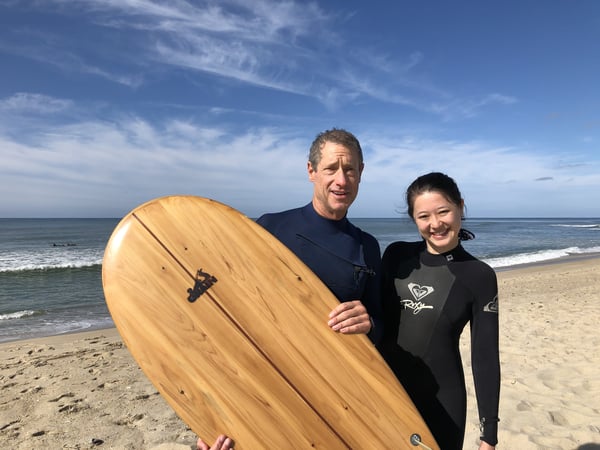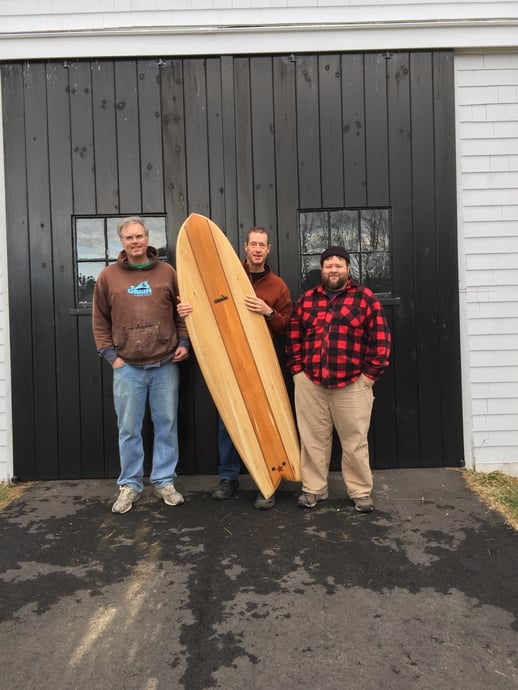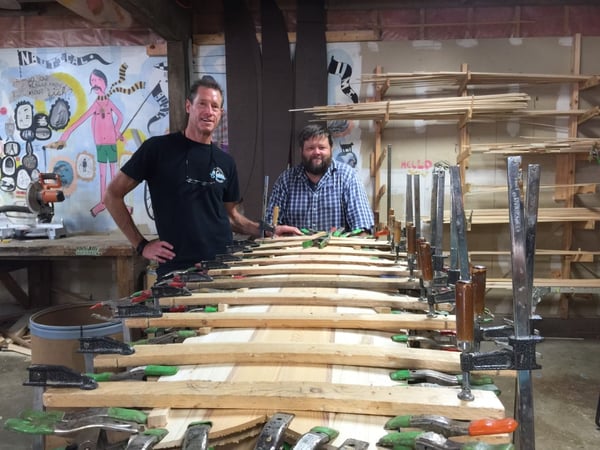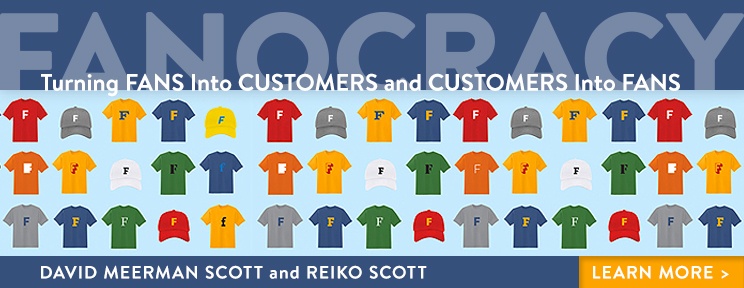Marketing | Best Practices | Fanocracy

Businesses that can gain the trust of their customers are poised to have incredible success.. Through my five years of research on fandom, I believe that putting the needs of customers above all else will help businesses build the trust necessary to win over consumers.
In this post, I’ll share how Grain Surfboards shares its manufacturing process with customers to build fandom. By creating with fans, Grain Surfboards grows fandom and trust that allows it to attract customers from across the globe.
This post is partly an excerpt from my Wall Street Journal bestseller book Fanocracy: Turning Fans into Customers and Customers into Fans. I wrote Fanocracy with my daughter Reiko (that's her in the photo of me with the Grain Surfboards "Paipo" model I made).
How Grain Surfboards Builds Fandom
I’m a massive fan of surfing (can’t say I’m an expert at it, though). Surfing is one of the most natural of athletic activities — it’s just you against the elements. The ocean is free for anybody who wants to jump in and catch some waves. The equipment is simple — a surfboard and in colder climates a wetsuit to stay warm.
For people who care about the environment though, standard surfboards have significant drawbacks. The first problem is the carbon footprint required to make surfboards: the raw material, foam, shipping huge chunks of foam core to manufacturers, then shipping the finished surfboards to distributors and retail stores uses a lot of resources. And when boards break or are no longer useful, their enormous size makes the difficult to dispose of in landfills.
Surfers began seriously looking for alternatives to foam in the mid 2000s, at the same time that Mike LaVecchia founded Grain Surfboards, a company dedicated to building surfboards out of sustainable wood. The surfboards that originated in Hawaii over a hundred years ago were made from wood. However, they were made from one large plank and were incredibly heavy. They were long and wide in order to hold a person, but this made them difficult to maneuver in the water. LaVecchia pioneered the use of traditional boat building techniques with ribs and planks to make hollow wooden surfboards. This innovation was exactly what was needed to give wooden boards the lightness and ability to turn that foam models have. The custom-built boards cost between $1,900 and $2,500, more money than factory-built foam boards.
“For the first year or a year and a half we were just making boards and we were trying to figure out how to do it, what the techniques were that we wanted to use so we were trying lots of different things,” LaVecchia told us. “We quickly decided that it made sense to offer boards in other formats because it’s expensive for customers to buy a custom board.”
Initially, LaVecchia offered a kit so that people could make their own boards at home.
By giving people all of the materials, plans and detailed directions, Grain Surfboards was essentially inviting people to copy its proprietary surfboard building techniques.
The vast majority of companies protect their intellectual property, yet LaVecchia thought it would, in fact help their surfboards gain popularity.
“We really enjoyed putting together kits and getting them out there,” LaVecchia says. “Our whole thing has always been the more wooden boards the better no matter how you do it. Wood is a great alternative to foam, and we want to help people use it. So, it didn’t matter if we built the board or if our customer built it. We’re about getting wooden boards out there and proving to people that they are viable.”
Grain Surfboards packaged up their secrets in the form of a kit with detailed directions. However, there’s more to how Grain Surfboards invited customers to participate in the creation of their own surfboards as they discovered another untapped market.
LaVecchia and the team at Grain Surfboards were getting inquiries from people who liked the idea of making their own wooden surfboard but didn’t have the proper tools or woodworking experience.
“There was a growing number of homebuilders that were a bit scared of diving into a kit project at home,” he says. “The people who were confident had already bought a kit from us and were building, yet there were a whole lot of people who just needed a little help.”
That’s when The Grain Surfboards 4-Day Workshop was born!
Treat Your Fans Like Family

Wooden surfboard enthusiasts flock to the Grain Surfboards shop in York, Maine, working side-by-side with the company’s artisans to build a board of their own. Regularly scheduled classes at the factory are held once per month for up to eight students, and they add additional classes as needed. In addition, Grain Surfboards has a traveling class on the West Coast that stops near surf spots in California and Oregon, as well as running a satellite workshop in Amagansett, New York.
I’ve gone through the experience at the Maine factory… twice! I loved it so much the first time that I came back again to build a second board. Planning the board down to every detail is something I enjoyed. That includes personalizing my boards with a “logo” — the same red star tattoo I sport on my ankle is embedded into my two finished surfboards. There’s a lot of shaping work with knives and sanding to get the finish right. I found that I enjoyed using a different part of my brain than I normally do for a few days.
What I loved the most was interacting with the team from Grain Surfboards as well as the other students. We met in the mornings around big a communal table and eat breakfast together. From our whiteboard talk we’d learn what we were to accomplish that day and we’d all be eager to get to work. The Grain staff is there to help as much or as little as you need. They jump in to help you with the more delicate parts of the project, such as properly aligning the top of the board to the bottom (“closing the coffin” in Grain speak). Over lunch and at the end of the day, sharing a beer or two, we talked (or told tall tales) about our surfing adventures. At my first class, I participated with a father and his 12-year-old daughter who made a longboard together and a young man who had travelled all the way from India to make a shortboard. Little things like that bonded us students to Grain staffers in a personal and powerful way.
“There’s a lot of small steps and when you’re first getting used to tools, there’s room for error,” LaVecchia says. “The closer you get to the finished product the more dialed in you’re getting with all your tools. It’s a rewarding process in that way. I think our students really enjoy working with us. For four days, it’s like they’re part of our crew. They’re using all the same tools we’re using. If we’re working on some custom boards the students can see what we’re doing, so everybody gets immersed in the culture here.”
An added benefit of the York, Maine factory location is being walking distance to Long Sands Beach. So, if surf is up, students and crew can go out into the waves together. There are loaner boards available for students to try, which is how I ended up wanting to return to build a second board. I tried out the Paipo model, loved it and wanted to make my own.
“I always joke that classes are great because it gives us a monthly excuse to stop and clean the shop to make it presentable,” LaVecchia says. “Funny, yet it’s honestly something we really love and look forward to having people here. It brings new life here anytime we do a class it gets us excited to meet all these people. We just had a call ten minutes ago from a guy who has been coming here for the last year to visit and trying to schedule a class. But life was busy for him. He’s a fireman and it took him a solid year to actually get here. He finally came in April to build a board and he just called to check in. Now we know his daughter — she went to school in Boston and now she’s moving home. It’s like they’re all just now part of the part of the family. Everybody who comes here somehow feels like they never really leave. Whether they come back to visit, or they just call to check in or post some photos of their board on social media. We truly value and enjoy getting to know all these people, it feels like we have this constant growing family.”
And I can confirm that from the other side, it feels like I’m part of the family too. I even sport a Grain Surfboards sticker on my MacBook Pro. I am a loyal and enthusiastic fan!
Grain Surfboards has built a Fanocracy around their company that simply wouldn’t have been possible had they stuck to just the transaction of selling wooden boards and shipping them to customers and dealers. People like me share our passion for the boards that we make ourselves by posting on social media, especially Instagram, which further fuels interest in the custom board building experience. The @grainsurfboards Instagram feed showcases boards, classes, and surfing and as I write this has more than 50,000 followers.
Giving people a chance to experience what most don’t see is good business. The power of providing fans something special can move an organization from simply selling, to forging the memorable experiences that last a lifetime.
Sharing My Grain Surfboards Fandom

When one of my handmade Grain Surfboards appears on the beach or in the lineup waiting for a wave, other surfers immediately notice the unusual wooden surfboard in a sea of typical form models. “Wow!” They say to me. “Cool wooden board!”
Saying I made the surfboard myself always gets people to stop and want to chat. “You made it?” That’s my opening to share my story about Grain Surfboards, while pointing at the company name burned into the wood with a hot branding tool. They love hearing about the class including my choice about the type of board, selecting the wood, learning to use the tools, and putting the work in to build it myself. While the beautiful board generates attention, my enthusiasm for the process is what gets others really interested. My passion shines through and people always want to know more. Where is this place? How many other people are there? How long does it take? Is it difficult? Is it expensive? What fun!
At a surf spot I frequent on Nantucket Island, people recognize my board more often than they recognize me! “Here comes wooden surfboard dude!”
Making fans a part of the action at Grain Surfboards has allowed the company to build a brand that consumers love. By including customers in the creation of their own surfboards, Grain Surfboards forges meaningful bonds with its customers. In the Edelman survey, 75% of people said they value trust over trendiness. Grain Surfboards has invested in fandom to provide what we all want in all the companies we buy from: trust.
As a result, the company has built a passionate international Fanocracy of people who are eager to be a part of what they do. Those fans, like me, share their experiences on social media. And on the beach.
Want to learn how to build fans like Grain Surfboards?
A great way to create love for what you do is figure out ways to let people into your world, like Grain Surfboards does. Allow customers to create their own experience or be an important part of what you do. While everyone else is making products and services sold via transactions, you create fans!
My new book, Fanocracy: Turning Fans into Customers and Customers into Fans, explores ways for businesses to harness the power of fandom to grow and succeed. In the meantime, you can see other businesses that have been using fandom to succeed and some of my favorite fandom examples of 2019.




